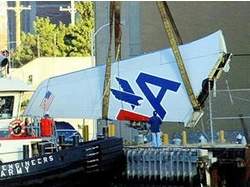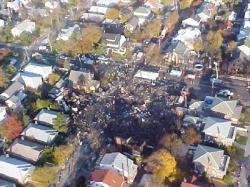Co-Pilots Rudder Movements "Unnecessary And Aggressive"
 The way AAL 587 copilot Sten Molin
manipulated the Airbus A300-600's rudder pedals was the probable
cause of the November 2001 crash that killed all 260 people on
board, as well as five on the ground, according to an NTSB
investigator who spoke in Washington Tuesday.
The way AAL 587 copilot Sten Molin
manipulated the Airbus A300-600's rudder pedals was the probable
cause of the November 2001 crash that killed all 260 people on
board, as well as five on the ground, according to an NTSB
investigator who spoke in Washington Tuesday.
"The first officer's control wheel and rudder inputs during the
second wake encounter were unnecessary and too aggressive," said
investigator Robert Benzon.
But there were other contributing factors, Benzon said --
including the way American Airlines trains its pilots to deal with
wake turbulence and the way the airline sets up its simulators to
mimic such events. The NTSB investigator also cited the rudder
control system itself as being sensitive at higher speeds.
AAL 587 went down in Belle Harbor (NY), just two minutes after
departing JFK on its way to the Dominican Republic, after hitting
turbulence on climb-out. Molin, who was flying the plane,
repeatedly swung the rudder from stop to stop, a technique he was
trained to perform when trying to regain control of the aircraft in
heavy turbulence.
"Hang onto it, hang onto it," Capt. Edward States urged.
"Let's go for power, please," Molin said.
 But just a second later, the sound
of a loud bang could be heard on the CVR, a sound marking the
delamination of the vertical stabilizer, according to
investigators. Alarms sounded in the cockpit.
But just a second later, the sound
of a loud bang could be heard on the CVR, a sound marking the
delamination of the vertical stabilizer, according to
investigators. Alarms sounded in the cockpit.
"What the hell are we into (inaudible)?" Molin said. "We're
stuck in it."
Five seconds later, States uttered his last words: "Get out of
it! Get out of it!"
Molin obviously didn't know
that he was applying more pressure to the rudder pedals than the
vertical stabilizer was designed to take. Why that happened and
who's responsible -- those are questions that continue to
linger. Airbus blames Molin and American
Airlines. But awash in red ink, facing huge liability exposure and
certain that their pilot training was adequate, AAL executives say
the problem was in the design of the aircraft itself. They believe
the A300-600's maker, Airbus, should shoulder all or at least some
of the liability in the 280 lawsuits stemming from the November 12,
2001 accident.
 Key to American's argument is a
recently-discovered internal memo at Airbus pointing to known flaws
in the design of the A300 rudder system. The memo, written in June,
1997, came from Daimler-Benz Aerospace, one of Airbus's production
partners. In part, the memo said, "rudder movements from left limit
to right limit" on an A300 "will produce loads on the fin/rear
fuselage above ultimate design load."
Key to American's argument is a
recently-discovered internal memo at Airbus pointing to known flaws
in the design of the A300 rudder system. The memo, written in June,
1997, came from Daimler-Benz Aerospace, one of Airbus's production
partners. In part, the memo said, "rudder movements from left limit
to right limit" on an A300 "will produce loads on the fin/rear
fuselage above ultimate design load."
If Airbus had shown the memo to the NTSB before the crash of
Flight 587 "instead of concealing it from them, the NTSB would have
issued the recommendation before the crash," said John A. David, an
American Airlines pilot who is the chief representative of the Air
Line Pilots Association in the investigation.
American spokesman Bruce Hicks wholeheartedly agreed. "It's easy
to focus on what started the sequence of events" that led to the
crash, he said. "Airbus never told safety investigators about
previous incidents."
But American pilots and executives knew about at least one
incident that occurred in 1997 -- because one of their own planes
was involved. An A300-600 on approach to West Palm Beach (FL)
almost crashed when the flight crew tried a similar side-to-side
rudder movement to steady the plane in turbulence. The aircraft
almost fell out of the sky. One person was seriously hurt.
Shortly after the crash of AAL 587, the aircraft involved in the
1997 incident was given a closer look. Inspectors found cracks in
the vertical stabilizer and ordered it replaced.
 ANN's Daily Aero-Linx (04.15.24)
ANN's Daily Aero-Linx (04.15.24) Classic Aero-TV: 'No Other Options' -- The Israeli Air Force's Danny Shapira
Classic Aero-TV: 'No Other Options' -- The Israeli Air Force's Danny Shapira Aero-News: Quote of the Day (04.15.24)
Aero-News: Quote of the Day (04.15.24) Airborne 04.16.24: RV Update, Affordable Flying Expo, Diamond Lil
Airborne 04.16.24: RV Update, Affordable Flying Expo, Diamond Lil ANN's Daily Aero-Term (04.16.24): Chart Supplement US
ANN's Daily Aero-Term (04.16.24): Chart Supplement US





